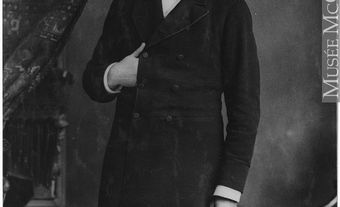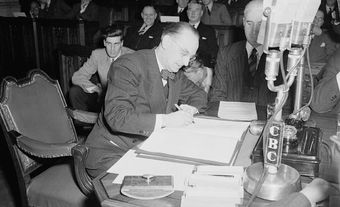On 13 May 1861, 2,000 protesters gathered outside the Colonial Building in St. John’s, Newfoundland. They objected to actions taken by the colony’s governor, Sir Alexander Bannerman, during the recent, highly contentious election; he had defied responsible government and install a new, Conservative government. The protest turned into a riot that damaged property and resulted in the deaths of three people. It took months to settle the political stalemate. The Conservatives won by-elections in disputed ridings and remained in power. The riot led to new laws that protected polling stations, saw police officers keep the peace instead of soldiers, and discouraged events and practices that could lead to violence.

Background
In the 1850s, the British colony of Newfoundland was rife with overlapping ethnic, religious and political divisions. In 1857, the population was 46 per cent Catholic and 52 per cent Protestant. Nearly all Conservative Party members were Protestants and vitrually all Liberals were Catholics. They fought over appointments, policies, and which party would form the next government. Native-born and Irish-born Catholics also argued among themselves.
In 1855, Newfoundland was granted full Dominion status and a responsible government. Britain would still appoint a governor to oversee the colony, but the people would elect a government that would be responsible to them. The government would have the power to create laws, raise revenue and approve spending. The Liberals won the 1855 election, making Phillip F. Little, a Catholic, Newfoundland's first prime minister.
In 1858, the Liberals were still in power and its new leader, John Kent, was prime minister. But the Liberal Party and the government had been weakened by disagreements between Kent and Catholic Bishop John Thomas Mullock. Mullock took the unprecedented move of withdrawing the Catholic Church’s support for the governing Liberals. Political instability and sectarian tension were further enhanced by public arguments between Kent and the Protestant, anti-Catholic governor, Sir Alexander Bannerman.
Bannerman had been appointed governor of Prince Edward Island in 1851 with orders to implement responsible government. He was appointed to the Bahamas after serving in PEI but was transferred to Newfoundland in 1857. He was told by the Colonial Office to make responsible government work there.

Currency Bill Conflict
The Kent government was growing increasingly unpopular due to actions it had taken and because of the economic hardship the colony was experiencing. In February 1861, Kent introduced a currency bill intended to create one type of money for the Dominion (at the time, it used both British and Newfoundland currency). If passed, the bill would have meant that all government officials would be paid in Newfoundland currency; and because it was worth less than the British currency, all would see their incomes reduced. Since many of those affected were Protestants, the Conservative Party opposed the currency act.
Newfoundland Supreme Court justices, who would also see their salaries cut, asked Conservative Party leader Hugh Hoyles to argue against Kent’s proposal. Meanwhile, Governor Bannerman let it be known that he opposed the bill and considered Kent and his ministers incompetent. Premier Kent accused the justices and governor of conspiring against him.
In response, Governor Bannerman dismissed Kent and his government. He appointed a Conservative government with Hoyles as premier. Conservatives were ecstatic and Liberals were outraged. Bannerman’s action openly defied his instructions from Britain to respect the concept of responsible government. Historian Gertrude E. Gunn has called it an “extra-constitutional coup d’état.”
Setting aside his past criticisms of Kent, Catholic Bishop Mullock denounced Bannerman’s action and pledged his renewed support for Kent and the Liberals, who still held more seats in the assembly. Shortly after taking office, the legislative assembly defeated the Hoyles government in a non-confidence vote.

General Election, 2 May 1861
Governor Bannerman set an election for 2 May. Bishop Mullock stated that he would support Kent and the Liberals and that it was the duty of every Catholic to do the same. Anglican bishop Edward Feild stated that it was the duty of all Protestants to support Hoyles and all Conservative candidates.
Unsurprisingly, Conservative candidates won predominately Protestant ridings and predominant Catholic ridings elected Liberals. In the colony’s swing ridings of Harbour Grace, Burin and Harbour Main, the campaigns and voting day were violent. In Harbour Grace, the Liberal candidate had no Conservative opponent. However, due to a threat of violence, the polls were not allowed to open; Bannerman declared that Harbour Grace would have no representative until a by-election could be held.
No Conservative candidate ran in Harbour Main, but four Liberals contested the district’s two seats. In one village in the riding (Cat’s Cove), political rivals argued, fought, and caused property damage. Soldiers were deployed to restore order; one man was killed and ten others were wounded. After the returning officer declared all four Liberals elected, Bannerman declared the Harbour Main election invalid. He said none of the Liberals would take the two seats until an assembly committee, dominated by Conservatives, determined who had won.
Bannerman asked the Conservatives to form a government, since 14 Conservatives and 12 Liberals had been elected. The Liberals, however, said that the questionable legality of the events at Harbour Grace and Harbour Main meant that they had really won the majority of seats and should form the government.

Mullock served as the Roman Catholic Bishop of Newfoundland for 20 years. His intervention in the 1861 election ultimately led to the decline of his influence.
The Riot
On 13 May, the new Conservative government met at the St. John’s Colonial Building. Bishop Mullock and several Liberal leaders encouraged their supporters to gather outside. Two of the four Harbour Main Liberals attempted to take seats in the assembly but were expelled. The growing crowd demanded that the Liberals be allowed to form the government.
By the time the governor arrived to deliver his speech from the throne, more than 2,000 angry protesters had gathered. Bannerman called troops from the local garrison to protect the building and the staff and politicians trapped inside. When armed troops began escorting members of the assembly out the front entrance, the crowd surged forward but then let them pass.
Other protesters threw rocks and other projectiles through windows in streets around the Colonial Building. The houses of Conservative politicians and their supporters were attacked. Soldiers were ordered into the streets to quell the violence, but the aggressive move only made things worse. A judge appeared on the Colonial Building’s steps and read the riot act; people had one hour to disperse or be found guilty of a felony. The reading focussed the angry crowd back on the Colonial Building and soldiers reassembled to protect it. Priests moved through the crowd pleading with people to go home.
Someone from the crowd fired a weapon at the troops. They returned fire. Twenty people were wounded and three were killed. Among the dead was a Catholic priest who had been urging people to leave. Bishop Mullock had the nearby cathedral ring its bells to summon those still rampaging in the streets to come to the Colonial Building. He begged people to go home and, finally, they did.
Aftermath
It took months to settle the political stalemate. By-elections were held in the disputed ridings. The Conservatives won the seats and Hugh Hoyles remained premier.
A petition signed by 8,000 Catholics, including Bishop Mullock, was sent to the Colonial Office in England. It accused Bannerman of “constitutional despotism” and blamed him for the corrupt, violent election and the riot. The Colonial Office took no action against Bannerman. He retired in September 1864 and died in London shortly afterward.
Governors who succeeded Bannerman were more willing to allow responsible government to work. Party membership began to include both Protestants and Catholics and factions within both. Direct clerical involvement in partisan politics continued but became less overt. Bishop Mullock withdrew from politics, and the Catholic and Protestant churches both turned their focus to running the colony’s schools. The Hoyles government increased the size of local constabularies so police officers rather than soldiers kept the peace. New laws protected polling stations, oversaw elections, and discouraged events and practices that could lead to violence.
See also Sir Ambrose Shea; Politics in Newfoundland and Labardor; Newfoundland and Labrador and Confederation

 Share on Facebook
Share on Facebook Share on X
Share on X Share by Email
Share by Email Share on Google Classroom
Share on Google Classroom


